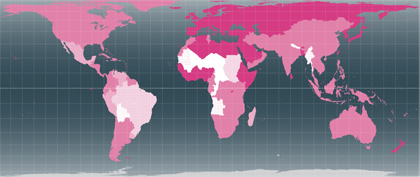Floras Schätze. Die Erfassung der Grünen Welt
| Floren – Regionen |
| Dieser Ausstellungsteil vermittelt mit Hilfe der äußerst reichhaltigen Sammlungen der Bibliothek des Botanischen Museums Berlin-Dahlem einen umfassenden Überblick über die weltweit wichtigsten und aktuellsten Florenprojekte, gegliedert nach Erdteilen. Zentraler Blickfang des Raumes ist die große Weltkarte. Sie führt anschaulich vor Augen, dass die floristische Erfassung der Welt auch im 21. Jahrhundert keineswegs abgeschlossen ist. Bis heute ist unser Bild von Pflanzenkleid der Erde so lückenhaft, dass „weiße Flecken“ auf der botanischen Weltkarte verbleiben. Auch die bereits erhobenen Informationen müssen kontinuierlich aktualisiert werden, denn das Auftauchen und Verschwindens von Arten wird durch die massiven, vom Menschen verursachten Eingriffe weltweit immer stärker beschleunigt. |
  |
| Links · left: Blick in die Ausstellung. Exhibition view. Foto: C. Hillmann-Huber, BGBM Rechts · right: Von der zehnbändigen Flora der Volksrepublik Korea lassen sich in Europa nur zwei Exemplare nachweisen, eines davon in Berlin-Dahlem. Only two European institutions provide a copy of the ten-volume Flora of the People´s Republic of Korea, one of them being Berlin-Dahlem. |
| Floras – Regions |
| This exhibition chapter provides an extensive overview of the most significant and most recent flora projects worldwide by continents, building on the rich collections of the Library of the Botanical Museum Berlin-Dahlem. In the center of the exhibition room is a large map of the world. It demonstrates that even in the 21st century there are still gaps in our picture of the vegetal dress of this planet. Several uncharted areas remain, but also the data already gathered has to be updated continuously. The dynamics of the appearance and disappearance of species worldwide is severely accelerated by human intervention. |
 |
| Floristische Erfassung der Welt im Jahr 2010, details siehe Ausstellung und Katalog. Status of worldwide floristic mapping in the year 2010, for details see exhibition and catalogue. © BGBM, Freie Universität Berlin |





